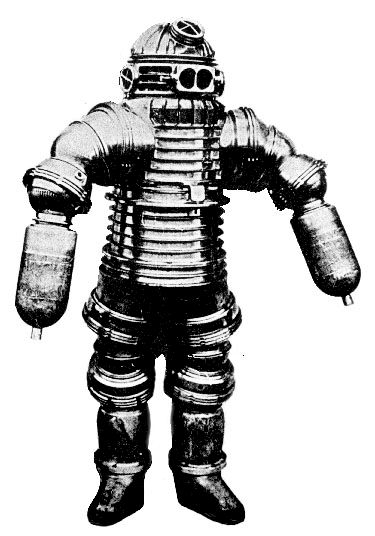|
It was generally recognized in
the early part of the 20th Century that the ordinary rubber diving dress
was limited to the depth of operation it could safely bre used at.180
feet was the depth to which practical work could be carried out at and
although some experimental dives were made to a depth of 300 feet often
these were made with a loss of life.
What as the problem with the
rubber diving dress? Well, as the diver descends deeper the depth
becomes greater and the diver relies on compressed air inside the suit
to counteract the pressure from the surrounding water.
The diver also has the effect of the nitrogen which is absorbed into the
bloodstream to contend with as the body does not assimilate this
unwanted gas. The solution to this problem was to encapsulate the diver
in a rigid suit which could withstand the pressure of the surrounding
water whilst the diver inside was at normal atmospheric pressure.
Overcoming this problem would mean the diver could return to the surface
without long spells underwater decompressing whist ascending.
The idea of the one atmosphere suit was not new . It had been tried in
the USA , Italy, Australia and Germany but there was one major drawback,
that of providing flexible joints to a rigid piece of equipment.
The ‘Tritonia’ Deep
Diving Dress was to overcome this problem. Invented by Mr Peress of
Byfleet, England its flexibility and adaptability placed it in a class
of its own .
‘Pop’ Peress was to use one of nature’s solutions to the problem of
friction in joints, which is to surround the joint in a fluid. The
liquid whist being displaceable remains uncompressible and so the moving
parts of the joints never come in contact with each other. The first
test demonstrated the safe use of the Tritonia Equipment at depths of
440 feet but it is believed the equipment would function well at depths
of 1000 to 1200 feet. In fact the inventor believed the Tritonia could
be designed to work at depths of up to 2800 feet or half a mile.
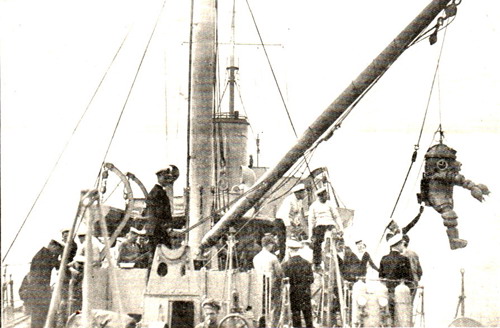
Admiralty Trials – HMS Tedworth and The Tritona being lowered into the
sea
After tank trials and
high pressure trials on the joints to pressures experienced at 1380 feet
the Tritonia was taken to Loch Ness on board the SS Recovery.
These trials were wholly successful. The Diver was James Jarratt and the
year was 1930. The suit has oxygen cylinders and sufficient air for 10
hours and the diver is in constant communication with the surface. There
is enough room inside the suit to withdraw the diver’s arms, eat, drink
and take notes.
The Tritonia is very delicately balanced in the water so with little
effort the operator can lie on the floor pick up items, tie knots etc…
It is also highly moveable and in one experiment at Spihead the diver
was able to walk against a current of 2 knots.
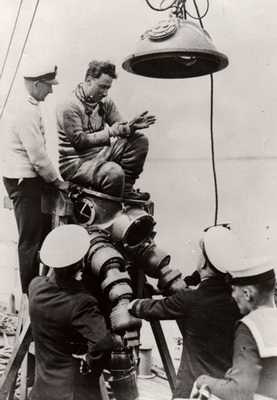 |
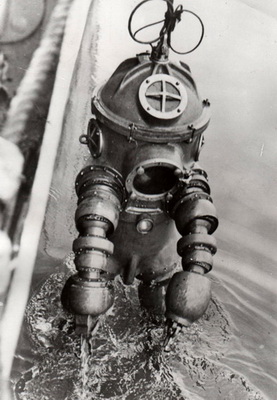 |
The inventor JS Peress explaining to the ships crew of the
SS Recovery the principles of the Peress Tritonia equipment |
The Tritonia being lowered into the water at the early
stages of the Deep water Trial in Loch Ness in Scotland |
In Conclusion JS Peress
wrote the following:
Scope for Usefulness
Great research , as well as much ingenuity and labour (involving an
outlay of more than £20,000) has been expended in bringing the Tritonia
Dress to its present stage of perfection.
To summarise the
position, the Dress can be used for the following purposes:-
For Naval requirements
such as saving lives from sunken submarines, and for destructive work
such as laying explosives.
For commercial salvage purposes such as the recovery of valuable cargoes
and bullion.
For gathering marine products of commerce such as pearls, mother of
pearl shells, sponges and corals
For scientific research
For submarine filming and photography.
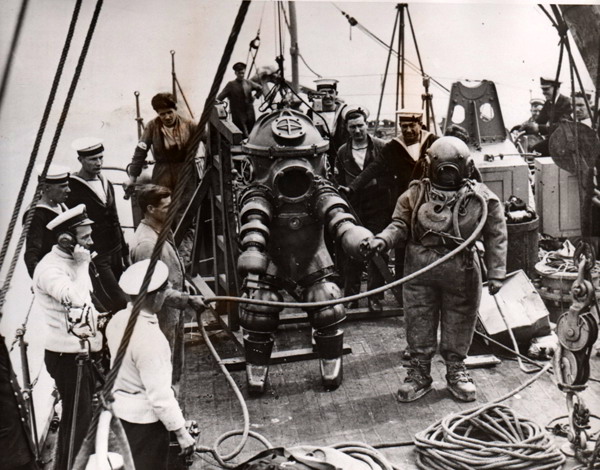
Photograph of the JS Peress Tritonia suit and a Standard divers dress on
board the SS Recovery in 1933 |
